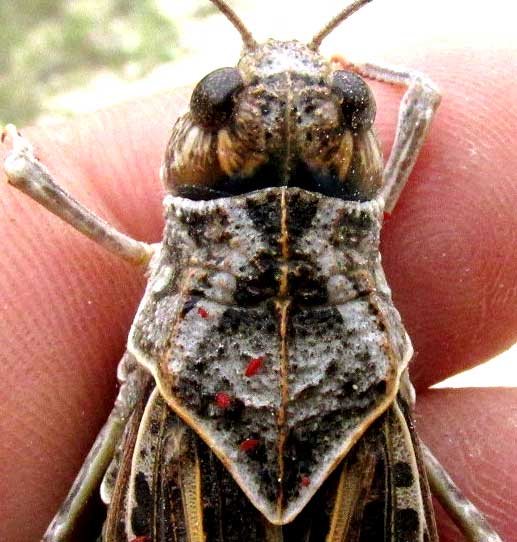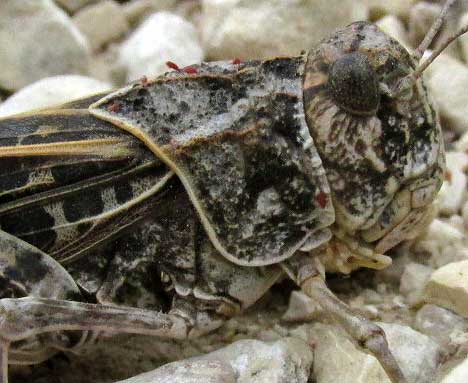Excerpts from Jim Conrad's
Naturalist Newsletter

from the September 7, 2014 Newsletter issued from the Frio Canyon Nature Education Center in the valley of the Dry Frio River in northern Uvalde County, southwestern Texas, on the southern border of the Edwards Plateau; elevation ~1750m (~5750 ft); N29.62°, W99.86°; USA
WRINKLED GRASSHOPPER
In the middle of a gravel road in the middle of the morning there sat the fairly large (1¾ inches, 45mm), boldly patterned grasshopper shown above. Even though the bicycle had almost run over him, he hadn't moved a bit, so I circled back to see if he'd stay still long enough to be photographed. Not only was that image allowed, but also I got the top view of his back, which was nicely marked with a distinctive white X, as seen below.

While photographing, I hadn't noticed the red items on his back, or pronotum. I'm guessing that the red things are mites, possibly of the family Erythraeidae, composed of parasitic mites, some of which are known to parasitize grasshoppers, and when they do so they look just like what's shown in our pictures. Maybe this parasitization explains why our grasshopper was behaving so lethargically. A side view of the same part of the grasshopper appears below:

The grasshopper was so sluggish that I caught him, and was able to see that his hind wings when opened displayed yellow and black splotches, shown below:

Grasshoppers can be hard to identify, but both volunteer identifier Bea in Ontario and I came up with the same name, which is the Wrinkled Grasshopper, HIPPISCUS OCELOTE, occurring throughout Mexico except for the Yucatan and Baja Peninsulas and in the US common east of the Rocky Mountains and the desert southwest, where it inhabits prairies, pastures, and fields, only occasionally turning up in open woods. It feeds on a variety of plants but prefers grass. Its occurrence seems to be spotty and never in large numbers, so it's not regarded as of agricultural interest. Recently I'd heard of vast swarms of grasshoppers in the Texas Panhandle farther to the north and had thought this might be one of them, but guess not.
Though our Wrinkled Grasshopper's bold, dark patterning really stood out on the white gravel road, in grassy areas the species' camouflage is very effective. Moreover, members of the species make themselves even harder to see by entangling themselves in grass blades.